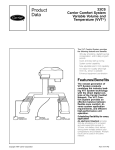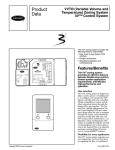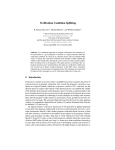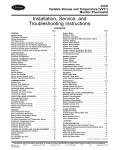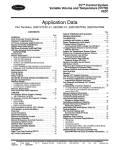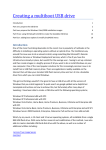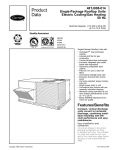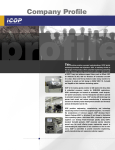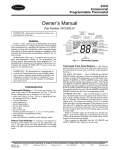Download Carrier CARRIER COMFORT SYSTEM 33CS Specifications
Transcript
33CS Carrier Comfort System Pressure Sensor Installation Instructions Part Numbers 33CSPS--01 and 33CSPS--02 PACKAGE USAGE PART NUMBER 33CSPS--01 33CSPS--02 USAGE Applications not exceeding 0.5 in. wg Applications not exceeding 2.0 in. wg PACKAGE CONTENTS ITEM Metal Enclosure Mounting Hardware Circuit Board Sensor Harness Power Harness QUANTITY 1 1 1 1 1 NOTE: The following items are field supplied: • 2⁄10 in. ID plastic tubing, long enough to be run from pressure probe to sensor mounting location • 18 gage, insulated, stranded wire, long enough to run from pressure sensor to damper actuator • 5 wire nuts • static pressure pickup (part number 920147), for static pressure control applications • velocity pressure probe (part number 920148 for 12 in. device, 920149 for 18 in. device, and 920150 for 26 in. device) for pressure independent control applications GENERAL The Carrier Comfort System pressure sensor is used for static pressure control and pressure independent control in VVTt systems. A field-provided pressure probe or pickup is mounted in the VVT system air duct. The pressure sensor reads the pressure from the pressure probe/pickup and sends the information to the VVT system component (zone controller or bypass controller). The pressure information is used to modulate the bypass or zone dampers when the system is in static pressure control mode or pressure independent control mode. NOTE: These sensors are designed for use with 33CSZC--01 zone controllers and 33CSBC--00 bypass controllers. 2. Mount the metal enclosure base to the duct or a suitable location. The operating environment for the sensor must remain between 32 to 130 F. The length of the pressure sensor tubing should not exceed 20 ft. The total length of the wire between the pressure sensor and the associated actuator should not exceed 100 ft. Recommended orientation of the sensor is with pneumatic tubing pressure ports toward the bottom. When properly installed, the pressure sensor will operate in any mounted position. 3. Push the pressure sensor circuit board down onto the standoffs until it locks into place. 4. The sensor wiring harness and power wiring harness should be attached to the circuit board. If they are not attached, push the plugs into the connector block on the pressure sensor circuit board. 5. Install the static pressure pickup or velocity pressure probe in the desired location. Run the field-supplied 2⁄10 in. ID plastic tubing from the pressure pickup/probe to the pressure sensor. Static pressure control applications will only use port P1. Port P2 is not used for static pressure control applications and should remain open to the atmosphere. Pressure independent control applications will use both ports P1 and P2. See Fig. 1. Do not wire pressure sensor or damper actuator while power is connected. Electrical shock or death could result. 6. Wire the pressure sensor to the damper actuator using the sensor wiring harness, field-supplied wire, and 3 fieldsupplied wire nuts. Clip and secure the orange, red, and black wires of the 6-wire section of the sensor wiring harness on the damper circuit board. They are not used. Wire nut the white, blue, and green wires on the wiring harness of the pressure sensor to the field-supplied wiring and run to the damper actuator. Connect them to the white, blue, and green wires on the damper actuator wiring harness. See Fig. 1 and 2. 7. Wire the pressure sensor power wiring to a 24 vac, 5 va power supply. See Fig. 1. 8. Install pressure sensor enclosure cover. The pressure sensor must be calibrated for proper operation. INSTALLATION IMPORTANT: Read these instructions completely before attempting to install the pressure sensor. Perform the following procedure to install the pressure sensor: 1. Attach the 4 plastic standoffs to the metal enclosure base with the 4 screws provided. Manufacturer reserves the right to discontinue, or change at any time, specifications or designs without notice and without incurring obligations. Book 1 4 PC 111 Catalog No. 533-303 Printed in U.S.A. Form 33CS-3SI Pg 1 7-95 Replaces: New Tab 11a 13a Fig. 1 — Pressure Sensor Tubing and Wiring Fig. 2 — Damper Actuator Wiring 2 6. When either noise level and/or drafts, due to supply airflow, becomes objectionable or the system static pressure approaches the upper static pressure limit, use Zone Damper Control to reopen the last zone damper that was closed. Open zone dampers until the noise level and/or drafts in every zone is acceptable or the unit supply air fan is able to exceed the minimum airflow requirements. This determines the maximum supply air static pressure the bypass controller should allow for the system. 7. Calibrate the pressure sensor. To calibrate the pressure sensor, select category 5, option 8. The current pressure reading will be displayed on the bypass controller screen. Use the left information buttons to adjust the value until the pressure matches the system pressure on the manometer or Magnehelic gage. 8. Press the select button and modify the Auto Pressure Set Point function (category 5, option 9). The current system pressure will blink. Increment or decrement the value to match the pressure reading of the Magnehelic gage. Press the select button. The new system pressure set point will be stored. CALIBRATION Static Pressure Pickup Calibration — To properly perform the calibration procedure, all associated devices with the VVTt system must be identified. The Communications Check option on the monitor thermostat (category 7, option 2) can be used to identify all network devices. The nominal pressure for the 33CSPS--02 is 2.0 in. wg. To calibrate the static pressure pickup, perform the following procedure: 1. Install a manometer or Magnehelic gage in parallel with the pressure sensor. Tee the Magnehelic gage high port into the high port of the pressure sensor. The low port must be open. The high pressure port is indicated with a P1 on the sensor. 2. Configure the bypass controller pressure sensor range (category 5, option 5). The default value of 2.0 in. wg is preset for use with the 33CSPS--02. Verify that it is set correctly. 3. Select the Auto-Zero Enable function in category 5, option 6. Set the option to ON. The bypass controller will automatically deenergize the equipment supply air fan. The bypass controller will allow the pressure in the ductwork to dissipate during the Fan Off Delay. The Fan Off Delay is configured in category 3, option 10. Two minutes will be added to the configured Fan Off Delay value. During Fan Off Delay, the bypass controller will display ‘‘ZERO’’to indicate that the auto-zero function is in progress. When the Fan Off Delay expires, the pressure sensor AutoZero Enable function will automatically calibrate the pressure sensor to zero. After the Auto-Zero Enable function completes the pressure sensor re-zeroing, the bypass controller display will return the Auto-Zero Enable function to OFF. 4. Set the System Setup Enable function (category 5, option 7) of the bypass controller to ON. The bypass controller scans all associated devices, deenergizes the system heating/cooling equipment, closes the bypass damper(s), and opens all the zone dampers in the VVT system to their Maximum Damper Position. The bypass controller also energizes the system supply air fan relay. This option forces the system into a static condition so that a stable system pressure can be obtained. By adjusting the minimum and maximum damper positions at individual zones, the system can be adjusted to balance airflow and obtain an acceptable noise level. The bypass damper will display the highest address found in its scan. 5. Use the Zone Damper Control function to close, one at a time, the zone dampers farthest away from the equipment supply air fan. Each time a zone damper is closed, check the noise level and objectionable drafts in the zones that remain open. Check the ability of the system supply air fan to maintain supply airflow above the minimum required supply airflow. Use the left upper and lower buttons to scan through the devices found by the bypass controller. The display will show the address and the damper position, OP for open, CL for closed. Push both upper and lower left buttons simultaneously to close or open the selected damper. Continue closing individual zone dampers until the noise or drafts, due to increased supply airflow, becomes objectionable in any zone or until the equipment supply air fan cannot maintain the minimum cfm requirements of the unit. NOTE: For systems utilizing temperature diversity, close dampers at an opposing solar exposure while leaving the other dampers open. Perform Step 2. The system should be balanced while performing this task to assure designed airflow. Velocity Pressure Probe Calibration — The nominal pressure for the 33CSPS--01 is 0.5 in. wg. To calibrate the velocity pressure probe, perform the following procedure: 1. Install a manometer or Magnehelic gage in parallel with the pressure sensor. Tee the Magnehelic gage high port into the high port of the pressure sensor. The high pressure port is indicated with a P1 on the sensor. Tee the Magnehelic gage low port into the low port of the pressure sensor. The low pressure port is indicated with a P2 on the sensor. 2. Configure the bypass controller pressure sensor range (category 5, option 5). The value of 0.5 in. wg should be set for use with a 33CSPS--01. Verify that it is set correctly. 3. Configure the zone controller Velocity Pressure Probe Gain option (category 5, option 6). The default value is 1.0. 4. Initiate the zone controller Auto-Zero function (category 5, option 7). Set the value to ON. The zone controller will position its damper full closed and measure the velocity pressure. Once this is complete, the zone controller will automatically turn the option to OFF. 5. Initiate the zone controller Position Damper function (category 5, option 8). Adjust the damper position until the desired velocity pressure is obtained at the manometer or Magnehelic gage. 6. Calibrate the pressure sensor (category 5, option 9). Adjust the displayed value until it matches the measured value of the manometer or Magnehelic gage. 7. Set the Minimum and Maximum Airflow Set Points (category 3, options 7 and 8). Set the Minimum Airflow Set Point to allow acceptable fresh air requirements. Set the Maximum Airflow Set Point so acceptable noise levels are not exceeded. 8. Set the Damper Size option (category 3, option 9). The value is set in square inches and is the cross sectional area in which the probe is located. 9. Enable Pressure Independent Control (category 3, option 4). Set the value to ON. 3 Copyright 1995 Carrier Corporation Manufacturer reserves the right to discontinue, or change at any time, specifications or designs without notice and without incurring obligations. Book 1 4 PC 111 Catalog No. 533-303 Printed in U.S.A. Form 33CS-3SI Pg 4 7-95 Replaces: New Tab 11a 13a




